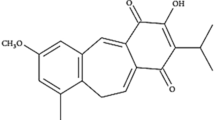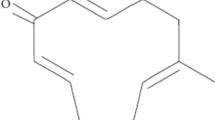Abstract
A number of studies have implicated tumor-induced Treg cell activity in the sub-optimal response to therapeutic vaccines. Development of neo-adjuvant strategies targeting Treg cells is therefore imperative. Scutellaria extracts or constituent flavonoids have shown encouraging efficacy against various tumors, including gliomas, in both pre-clinical and clinical studies. We report here, for the first time, that Scutellaria ocmulgee leaf extract (SocL) and flavonoid wogonin could inhibit TGF-β1-induced Treg activity in malignant gliomas. F344 rats, subcutaneously transplanted with F98 gliomas, were treated with SocL. There was a significant inhibition of intra-tumoral TGF-β1 and Treg cell frequency as well as peripheral blood TGF-β1 levels in SocL-treated animals compared to the controls. SocL extract and wogonin also inhibited glioma-induced, TGF-β1-mediated Treg activity in vitro. SocL extract and wogonin also inhibited the secretion of IL-10 in Treg culture; whereas the level of IL-2 was either unchanged or marginally enhanced. We also observed an inhibition of Smad-3, GSK-3β and ERK1/2 signaling by SocL and wogonin in Treg cells, while phosphorylation of P38 MAPK was considerably enhanced, indicating that SocL or wogonin could inhibit the T cells’ response to TGF-β1 via modulation of both Smad and non-Smad signaling pathways. Overall, this study suggests that Scutellaria can potentially reverse tumor-mediated immune suppression via inhibition of TGF-β1 secretion as well as via inhibition of T cells’ response to TGF-β1. This may provide an opportunity for develo** a novel adjuvant therapeutic strategy for malignant gliomas, combining Scutellaria with immunotherapy and chemo/radio-therapeutic regimen, which could potentially improve the disease outcome.






Similar content being viewed by others
Abbreviations
- CM:
-
Conditioned medium
- ERK:
-
Extracellular-regulated kinase
- GSK:
-
Glycogen synthase kinase
- nT:
-
Naïve T cells
- IHC:
-
Immunohistochemistry
- SocL:
-
Scutellaria ocmulgee leaf extract
- Treg :
-
Regulatory T cells
- TGF:
-
Transforming growth factor
References
Vega EA, Graner MW, Sampson JH (2008) Combating immunosuppression in glioma. Future Oncol 4(3):433–442
Shankaran V et al (2001) IFNgamma and lymphocytes prevent primary tumour development and shape tumour immunogenicity. Nature 410(6832):1107–1111
Galon J et al (2006) Type, density, and location of immune cells within human colorectal tumors predict clinical outcome. Science 313(5795):1960–1964
Domschke C et al (2009) Intratumoral cytokines and tumor cell biology determine spontaneous breast cancer-specific immune responses and their correlation to prognosis. Cancer Res 69(21):8420–8428
Rech AJ, Vonderheide RH (2009) Clinical use of anti-CD25 antibody daclizumab to enhance immune responses to tumor antigen vaccination by targeting regulatory T cells. Ann N Y Acad Sci 1174:99–106
Parajuli P et al (2007) Dendritic cell-based active specific immunotherapy for malignant glioma. Expert Opin Biol Ther 7(4):439–448
Waziri A (2010) Glioblastoma-derived mechanisms of systemic immunosuppression. Neurosurg Clin N Am 21(1):31–42
Fontana A et al (1992) Modulation of the immune response by transforming growth factor beta. Int Arch Allergy Immunol 99(1):1–7
Gajewski TF et al (2006) Immune resistance orchestrated by the tumor microenvironment. Immunol Rev 213:131–145
Gomez GG, Kruse CA (2006) Mechanisms of malignant glioma immune resistance and sources of immunosuppression. Gene Ther Mol Biol 10:133–146
Gorelik L, Constant S, Flavell RA (2002) Mechanism of transforming growth factor beta-induced inhibition of T helper type 1 differentiation. J Exp Med 195(11):1499–1505
Inge TH et al (1992) Inhibition of tumor-specific cytotoxic T-lymphocyte responses by transforming growth factor beta 1. Cancer Res 52(6):1386–1392
Pyzik M, Piccirillo CA (2007) TGF-beta1 modulates Foxp3 expression and regulatory activity in distinct CD4+ T cell subsets. J Leukoc Biol 82(2):335–346
Selvaraj RK, Geiger TL (2007) A kinetic and dynamic analysis of Foxp3 induced in T cells by TGF-beta. J Immunol 178(12):7667–7677
Liu VC et al (2007) Tumor evasion of the immune system by converting CD4+ CD25− T cells into CD4+ CD25+ T regulatory cells: role of tumor-derived TGF-beta. J Immunol 178(5):2883–2892
Lehe C et al (2008) The Wilms’ tumor antigen is a novel target for human CD4+ regulatory T cells: implications for immunotherapy. Cancer Res 68(15):6350–6359
Bohling SD, Allison KH (2008) Immunosuppressive regulatory T cells are associated with aggressive breast cancer phenotypes: a potential therapeutic target. Mod Pathol 21(12):1527–1532
Strauss L et al (2007) A unique subset of CD4+ CD25highFoxp3+ T cells secreting interleukin-10 and transforming growth factor-beta1 mediates suppression in the tumor microenvironment. Clin Cancer Res 13(15 Pt 1):4345–4354
Grauer OM et al (2007) CD4+ FoxP3+ regulatory T cells gradually accumulate in gliomas during tumor growth and efficiently suppress antiglioma immune responses in vivo. Int J Cancer 121(1):95–105
Perez N et al (2009) A genome-wide analysis of small regulatory RNAs in the human pathogen group A Streptococcus. PLoS One 4(11):e7668
Kotliarova S et al (2008) Glycogen synthase kinase-3 inhibition induces glioma cell death through c-MYC, nuclear factor-kappaB, and glucose regulation. Cancer Res 68(16):6643–6651
Humphries W et al (2010) The role of tregs in glioma-mediated immunosuppression: potential target for intervention. Neurosurg Clin N Am 21(1):125–137
Scheck AC et al (2006) Anticancer activity of extracts derived from the mature roots of Scutellaria baicalensis on human malignant brain tumor cells. BMC Complement Altern Med 6:27
Kyo R et al (1998) Baicalin and baicalein, constituents of an important medicinal plant, inhibit intracellular Ca2+ elevation by reducing phospholipase C activity in C6 rat glioma cells. J Pharm Pharmacol 50(10):1179–1182
Lee SW et al (2005) Beneficial effect of flavonoid baicalein in cisplatin-induced cell death of human glioma cells. Neurosci Lett 382(1–2):71–75
Parajuli P et al (2011) Delayed growth of glioma by Scutellaria flavonoids involve inhibition of Akt, GSK-3 and NF-kappaB signaling. J Neurooncol 101(1):15–24
Parajuli P et al (2009) In vitro antitumor mechanisms of various Scutellaria extracts and constituent flavonoids. Planta Med 75(1):41–48
Rugo H et al (2007) Phase I trial and antitumor effects of BZL101 for patients with advanced breast cancer. Breast Cancer Res Treat 105(1):17–28
Perez AT et al (2010) A phase 1B dose escalation trial of Scutellaria barbata (BZL101) for patients with metastatic breast cancer. Breast Cancer Res Treat 120(1):111–118
Mantena SK, Roy AM, Katiyar SK (2005) Epigallocatechin-3-gallate inhibits photocarcinogenesis through inhibition of angiogenic factors and activation of CD8+ T cells in tumors. Photochem Photobiol 81(5):1174–1179
Song CK et al (2007) Chemotherapy enhances CD8(+) T cell-mediated antitumor immunity induced by vaccination with vaccinia virus. Mol Ther 15(8):1558–1563
Kang TH et al (2007) Epigallocatechin-3-gallate enhances CD8+ T cell-mediated antitumor immunity induced by DNA vaccination. Cancer Res 67(2):802–811
Guo TL et al (2001) Genistein modulates immune responses and increases host resistance to B16F10 tumor in adult female B6C3F1 mice. J Nutr 131(12):3251–3258
Peng XD et al (2009) Correlation between anti-fibrotic effect of baicalin and serum cytokines in rat hepatic fibrosis. World J Gastroenterol 15(37):4720–4725
Zhou XM et al (2009) Inhibitory effects of citrus extracts on the experimental pulmonary fibrosis. J Ethnopharmacol 126(1):143–148
Du G et al (2009) Naringenin: a potential immunomodulator for inhibiting lung fibrosis and metastasis. Cancer Res 69(7):3205–3212
Bergmann C et al (2007) Expansion of human T regulatory type 1 cells in the microenvironment of cyclooxygenase 2 overexpressing head and neck squamous cell carcinoma. Cancer Res 67(18):8865–8873
Fantini MC et al (2007) In vitro generation of CD4+ CD25+ regulatory cells from murine naive T cells. Nat Protoc 2(7):1789–1794
Johnson LA, Sampson JH (2010) Immunotherapy approaches for malignant glioma from 2007 to 2009. Curr Neurol Neurosci Rep 10(4):259–266
Tada T et al (1991) Transforming growth factor-beta-induced inhibition of T cell function. Susceptibility difference in T cells of various phenotypes and functions and its relevance to immunosuppression in the tumor-bearing state. J Immunol 146(3):1077–1082
Wei WZ et al (2005) Concurrent induction of antitumor immunity and autoimmune thyroiditis in CD4+ CD25+ regulatory T cell-depleted mice. Cancer Res 65(18):8471–8478
Jacob JB et al (2009) Tumor regression following DNA vaccination and regulatory T cell depletion in neu transgenic mice leads to an increased risk for autoimmunity. J Immunol 182(9):5873–5881
Wang CZ, et al (2009) Selective fraction of Scutellaria baicalensis and its chemopreventive effects on MCF-7 human breast cancer cells. Phytomedicine 17(1):63–68
Huang WH, Lee AR, Yang CH (2006) Antioxidative and anti-inflammatory activities of polyhydroxyflavonoids of Scutellaria baicalensis GEORGI. Biosci Biotechnol Biochem 70(10):2371–2380
Nijveldt RJ et al (2001) Flavonoids: a review of probable mechanisms of action and potential applications. Am J Clin Nutr 74(4):418–425
Lin CC, Shieh DE (1996) The anti-inflammatory activity of Scutellaria rivularis extracts and its active components, baicalin, baicalein and wogonin. Am J Chin Med 24(1):31–36
Burdette-Radoux S et al (2004) Phase II trial of flavopiridol, a cyclin dependent kinase inhibitor, in untreated metastatic malignant melanoma. Invest New Drugs 22(3):315–322
Zelenskaya KL et al (2005) Stress-inducing effect of hypoxia of different origin and its correction with Inula Helenium L. tincture. Bull Exp Biol Med 139(4):414–417
Enomoto R et al (2007) Wogonin prevents immunosuppressive action but not anti-inflammatory effect induced by glucocorticoid. Ann N Y Acad Sci 1095:412–417
Chiu JH et al (2002) Tumor necrosis factor-producing activity of wogonin in RAW 264.7 murine macrophage cell line. Planta Med 68(11):1036–1039
Rubtsov YP, Rudensky AY (2007) TGFbeta signalling in control of T-cell-mediated self-reactivity. Nat Rev Immunol 7(6):443–453
Zhang YE (2009) Non-Smad pathways in TGF-beta signaling. Cell Res 19(1):128–139
Park IK, Letterio JJ, Gorham JD (2007) TGF-beta 1 inhibition of IFN-gamma-induced signaling and Th1 gene expression in CD4+ T cells is Smad3 independent but MAP kinase dependent. Mol Immunol 44(13):3283–3290
Lu L et al (2010) Role of SMAD and non-SMAD signals in the development of Th17 and regulatory T cells. J Immunol 184(8):4295–4306
Conery AR et al (2004) Akt interacts directly with Smad3 to regulate the sensitivity to TGF-beta induced apoptosis. Nat Cell Biol 6(4):366–372
Hua F et al (2010) Glycogen synthase kinase-3beta negatively regulates TGF-beta1 and Angiotensin II-mediated cellular activity through interaction with Smad3. Eur J Pharmacol 644(1–3):17–23
Voloshenyuk TG et al (2011) Induction of cardiac fibroblast lysyl oxidase by TGF-beta1 requires PI3K/Akt, Smad3, and MAPK signaling. Cytokine 55(1):90–97
Acknowledgments
We acknowledge research support from the USDA-NIFA (GEOX-2008-02989) and Fund for Medical Research and Education (FMRE). The Microscopy, Imaging and Cytometry Resources Core is supported, in part, by NIH Center grant P30CA22453 to The Karmanos Cancer Institute, Wayne State University and the Perinatology Research Branch of the National Institutes of Child Health and Development, Wayne State University. We are grateful to Dr. Larry Tait for the invaluable help with fluorescent IHC. We are thankful to Dr. Indrajit Sinha for his critical evaluation of the manuscript and also for his help with the preparation of the Figures.
Conflict of interest
The authors declare that they have no conflict of interest.
Author information
Authors and Affiliations
Corresponding author
Electronic supplementary material
Below is the link to the electronic supplementary material.
262_2011_1130_MOESM1_ESM.ppt
Supplementary Figure S1. SocL preferentially inhibits intra-tumoral FOXP3 + T reg cell activity without affecting total T-cell infiltration. F344 rats were subcutaneously transplanted with 1 × 106 F98 glioma cells on the right flank. SocL administration was performed as described. Rats were euthanized on day 29; the tumor was resected and processed for IHC, as described in the ‘Methods’ section, to determine the presence of FOXP3+ and CD3+ T cells. Result shown is from one representative paraffinized glioma specimen out of three studied. The micrographs were imaged at 200× magnifications. (PPT 12789 kb)
Rights and permissions
About this article
Cite this article
Dandawate, S., Williams, L., Joshee, N. et al. Scutellaria extract and wogonin inhibit tumor-mediated induction of Treg cells via inhibition of TGF-β1 activity. Cancer Immunol Immunother 61, 701–711 (2012). https://doi.org/10.1007/s00262-011-1130-3
Received:
Accepted:
Published:
Issue Date:
DOI: https://doi.org/10.1007/s00262-011-1130-3




